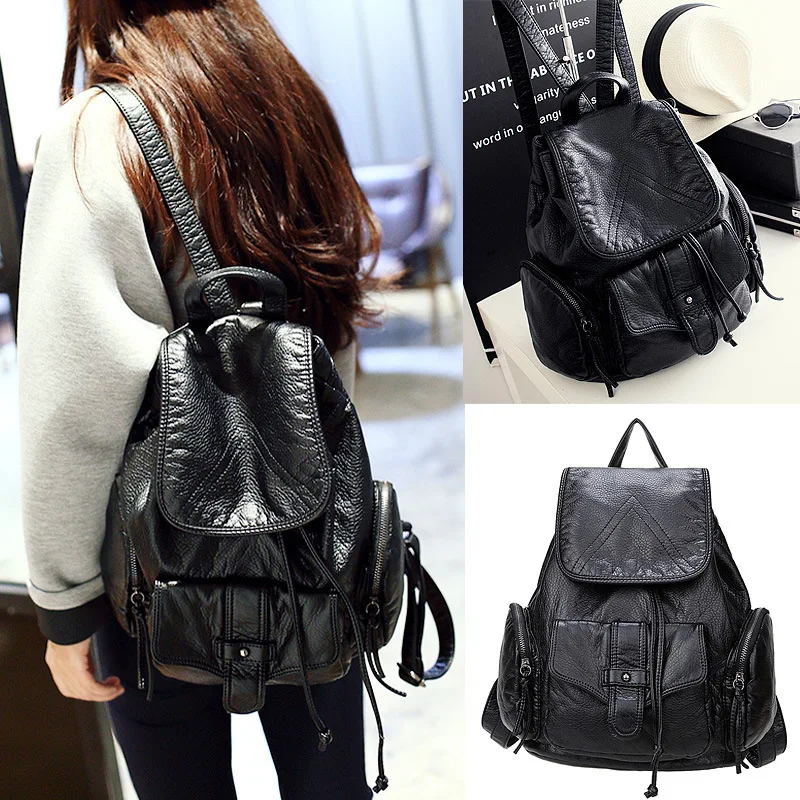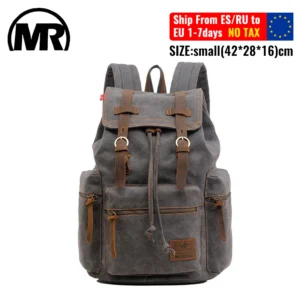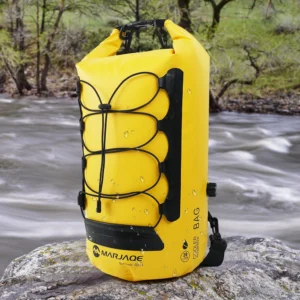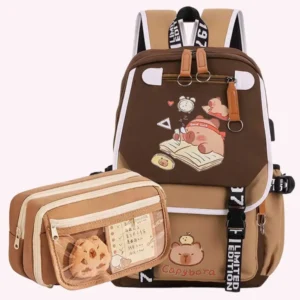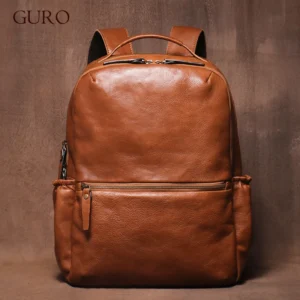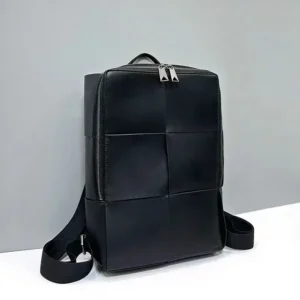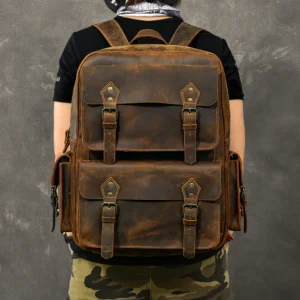Introduction to Roll-Top Leather Designs
Roll-top leather designs feature a flexible upper portion that can be folded or rolled down for secure closure, while allowing expansion when needed for additional carrying capacity. This distinctive feature has made roll-top backpacks and bags increasingly popular for both everyday use and travel.
The materials selected for roll-top leather designs directly determine their performance across several key factors: how long they’ll last, how well they function in different environments, their aesthetic appeal, and their environmental impact. When crafting premium roll-top products, material selection isn’t just about appearance—it’s about creating pieces that develop character over time while maintaining structural integrity.
What is a roll-top design?
A roll-top closure system features a flexible upper portion that rolls or folds down and secures with buckles, snaps, or other fasteners. This design allows for variable capacity and excellent weather protection.
Traditional roll-top designs relied primarily on thick vegetable-tanned leathers, while modern approaches incorporate a wider variety of materials, from chrome-tanned leathers to specialized hardware and synthetic components. Proper leather conditioning and waterproofing significantly extends the lifespan of these designs, ensuring they remain functional and beautiful for years.
I. Primary Leather Materials for Roll-Top Designs
The foundation of any quality roll-top design begins with leather selection. The type of leather used dramatically affects how the bag performs during daily use, how it ages, and how it stands up to the mechanical stress of rolling and unrolling. Roll-top leather backpacks showcase these materials in their most functional form, highlighting the importance of quality leather selection.
A. Full-Grain Leather
Full-grain leather represents the highest quality leather available, using the top layer of the hide with its natural grain pattern completely intact. This material hasn’t been sanded, buffed, or snuffed to remove imperfections or natural markings, giving each piece a unique character.
In roll-top designs, full-grain leather offers exceptional advantages:
- Superior Durability: The intact fibers provide unmatched tensile strength, ideal for withstanding the repeated folding of roll-top closures
- Beautiful Aging: Develops a rich patina over time that tells the story of your travels
- Natural Water Resistance: Becomes more water-resistant over time with proper care
- Structural Integrity: Maintains shape while allowing necessary flexibility
However, full-grain leather also requires consideration of:
– Break-in Period: Initially stiffer and requires time to soften and conform to use patterns
– Maintenance Needs: Requires regular conditioning to maintain optimal flexibility
– Weight: Typically heavier than other leather grades (5-8 oz or 2.0-3.2 mm thickness)
The ultimate guide to conditioning leather backpacks provides essential information for maintaining full-grain leather in roll-top designs, ensuring the material remains supple enough for folding while retaining its structural properties.
B. Top-Grain Leather
Top-grain leather represents the second-highest quality grade, created by sanding away the outermost layer to remove imperfections and create a more uniform appearance. This process results in a thinner, more pliable leather that’s particularly well-suited for the repeated folding required in roll-top designs.
Advantages for roll-top applications:
- Enhanced Flexibility: More immediately pliable than full-grain, requiring minimal break-in
- Consistent Appearance: Uniform look works well for mass-produced designs
- Stain Resistance: Often treated with protective finishes that resist water and stains
- Cost-Effectiveness: More affordable than full-grain while maintaining good durability
Considerations:
– Reduced Longevity: Not as durable as full-grain due to the removal of the strongest fibers
– Limited Patina Development: Develops less character over time
– Typical Thickness: 4-6 oz (1.6-2.4 mm) for ideal balance of structure and flexibility
Top-grain leather represents an excellent middle-ground option for roll-top designs where consistent flexibility is prioritized over maximum longevity.
C. Genuine Leather and Split Leather
Genuine leather and split leather represent lower-tier options made from the layers beneath top-grain and full-grain leather. Despite the somewhat misleading name, “genuine leather” actually indicates a lower quality product in the leather hierarchy.
| Leather Type | Durability | Flexibility | Aging Characteristics | Ideal Roll-Top Applications |
|---|---|---|---|---|
| Full-Grain | Excellent | Moderate (improves with use) | Develops rich patina | Primary exterior material |
| Top-Grain | Good | Good | Some patina development | Flexible rolling portions |
| Genuine | Fair | Variable | Minimal character development | Non-critical components |
| Split | Poor | High | Prone to stretching/wear | Rarely used in quality designs |
For roll-top applications, these materials have significant limitations:
– Lower tensile strength makes them less suitable for areas subjected to repeated folding
– Typically require additional coating or finishing to maintain appearance
– Often show wear more quickly, especially at fold points
– May require thicker applications or reinforcement to achieve necessary durability
These materials might appear in budget-friendly roll-top designs or as components in non-critical areas, but rarely form the foundation of premium products.
D. Specialty Leathers
Beyond standard leather grades, several specialty leathers offer unique characteristics particularly well-suited for roll-top designs:
Oil-tanned and pull-up leathers feature heavy oil and wax infusion throughout the leather, creating a distinctive “pull-up” effect where the color temporarily lightens when the leather is bent or folded—ideal for highlighting the rolling mechanism of these designs.
Crazy Horse leather, a variation of pull-up leather, offers a distressed, vintage appearance right from the start. The unique wax and oil treatment creates a surface that:
– Shows beautiful color variation at fold points
– Develops unique wear patterns that enhance character
– Offers excellent flexibility for roll-top applications
– Conceals scratches and marks through its intentionally distressed appearance
Vegetable-tanned leathers appeal to eco-conscious consumers and those seeking a more traditional approach. These materials change dramatically over time, developing deeper colors and unique patinas based on exposure to sunlight and handling.
For specialty roll-top applications, the recommended leather weight typically falls between 4-7 oz (1.6-2.8 mm), striking the ideal balance between structure and flexibility.
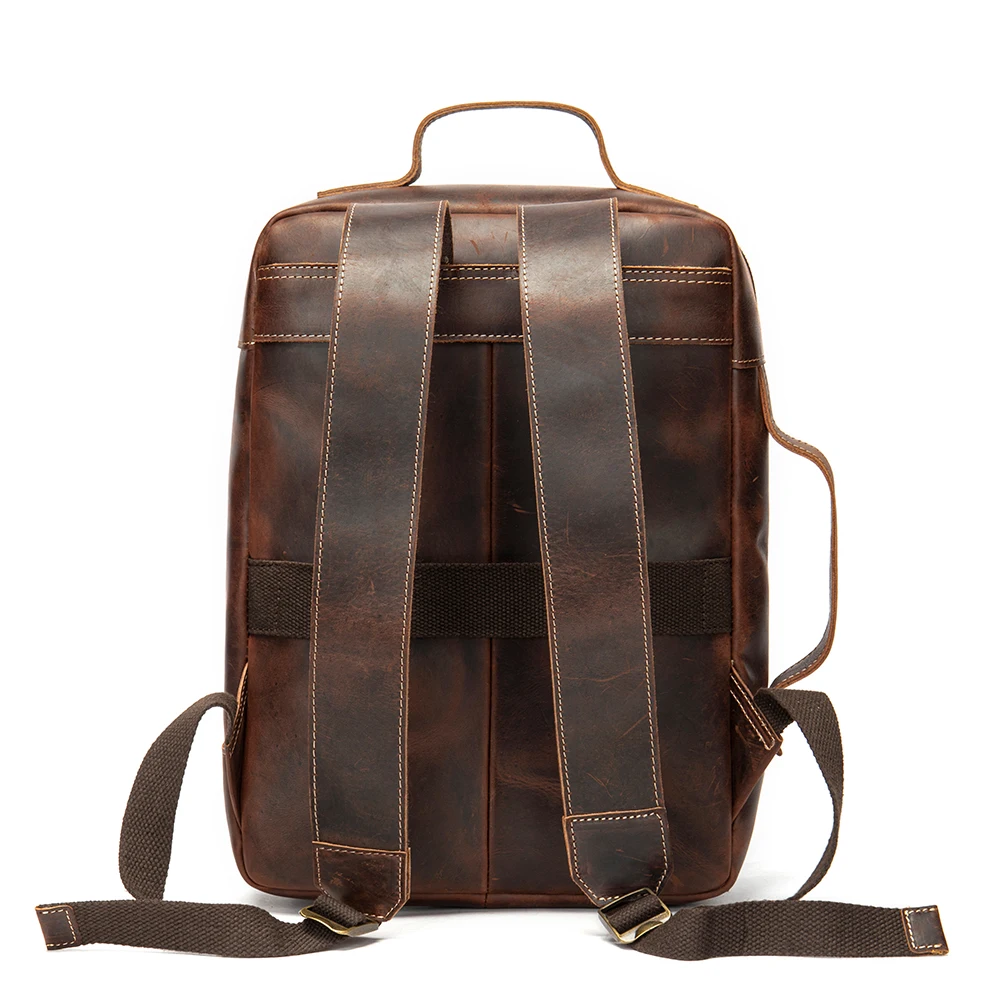
The Summit Carry collection of full-grain leather backpacks showcases how these premium leather options transform into functional, beautiful designs.
II. Tanning Methods and Their Impact
The tanning process fundamentally transforms raw animal hide into durable, usable leather. For roll-top designs, the tanning method directly impacts how the material performs during repeated folding and unfolding.
A. Vegetable-Tanned Leather
Vegetable tanning represents one of the oldest leather-making methods, using natural tannins extracted from plant materials like tree bark, leaves, and fruits. This traditional process takes 4-6 months to complete, resulting in leather with distinctive characteristics:
- Creates firmer structure that helps maintain the roll-top shape when closed
- Develops a rich, warm patina that deepens with sun exposure and handling
- Ages beautifully, with each mark and scratch telling the story of use
- Molds to use patterns over time, creating a personalized fit
Popular sources for vegetable tanning include oak bark (producing firm, water-resistant leather), mimosa (creating softer, more flexible leather), and chestnut (yielding rich reddish-brown tones).
Understanding how oil treatments affect vegetable-tanned leather is crucial for maintaining ideal flexibility in roll-top portions while preserving structural integrity. Regular conditioning prevents excessive drying that could lead to cracking at fold points.
B. Chrome-Tanned Leather
Chrome tanning represents the modern, industrial approach to leathermaking, using chromium salts to quickly transform raw hides into usable leather in just 24-48 hours. This efficiency makes chrome-tanned leather the predominant option in today’s market.
For roll-top applications, chrome-tanned leather offers several advantages:
- Exceptional softness and flexibility from the start, requiring minimal break-in
- Excellent water resistance, making it practical for weatherproof roll-top designs
- Wide range of consistent colors and finishes
- Maintains flexibility even in cold conditions
The environmental impact of chrome tanning remains a consideration, though many tanneries now implement closed-loop systems that recycle chromium and reduce waste. For users prioritizing immediate flexibility and weather resistance, chrome-tanned leathers provide excellent performance in roll-top designs.
C. Combination Tanning Methods
Combination tanning (sometimes called “combo-tanned” or “semi-vegetable tanned”) merges multiple tanning approaches to capture the best qualities of each method. These hybrid processes create leathers with balanced characteristics particularly valuable for roll-top designs:
- Initial chrome tanning provides flexibility, followed by vegetable tanning for added structure
- Oil-tanning processes enhance water resistance while maintaining excellent fold properties
- Specialized treatments improve performance in varied weather conditions
- Modern sustainable approaches reduce environmental impact while maintaining performance
These combination methods often produce leathers that perform exceptionally well in roll-top applications, offering the perfect balance of flexibility, structure, and durability. The specific tanning method affects not just the leather’s behavior but also determines which hardware components will integrate best with the material.
III. Hardware Components
The functionality of roll-top leather designs depends heavily on carefully selected hardware components that must work in harmony with the leather materials.
A. Closure Systems
The closure system represents the most critical hardware component in roll-top designs, securing the folded portion while allowing quick access when needed. Various closure options offer different benefits:
| Closure Type | Material Options | Weight | Durability | Weather Resistance | Aesthetic |
|---|---|---|---|---|---|
| Solid Brass Buckles | Brass | Heavy | Excellent | Excellent with patina | Vintage/Heritage |
| Stainless Steel Buckles | Stainless Steel | Moderate | Excellent | Excellent | Modern/Minimalist |
| Nickel-Plated Hardware | Plated Base Metal | Light | Good | Good (may show wear) | Bright/Contemporary |
| Magnetic Clasps | Various Metals | Light | Moderate | Variable | Sleek/Modern |
| G-Hooks | Aluminum/Steel | Very Light | Good | Good | Technical/Outdoor |
When selecting closure hardware for roll-top designs, manufacturers must balance several factors:
- Security: Must remain closed under normal movement and strain
- Ease of use: Should open and close efficiently without excessive effort
- Weather protection: Must create a reliable seal against the elements
- Weight distribution: Heavier hardware must be balanced against overall bag weight
Understanding different roll-top backpack closures helps users select the system that best meets their needs for security, convenience, and aesthetic preferences.
B. Reinforcement Hardware
Strategic reinforcement hardware protects high-stress areas in roll-top designs, particularly where the rolling portion connects to the main body or where straps attach. Key reinforcement components include:
- Rivets: Metal fasteners that join multiple layers securely while distributing stress
- D-rings and O-rings: Connection points for straps and accessories
- Binding hardware: Reinforces edges and prevents stretching
- Corner protectors: Guards vulnerable points against wear
Material selection for these components involves careful consideration:
- Solid brass offers classic appearance and excellent durability but adds weight
- Stainless steel provides corrosion resistance and strength with moderate weight
- Aircraft-grade aluminum delivers strength with minimal weight penalty
- Copper and bronze provide distinctive aesthetics with good durability
Proper placement of reinforcement hardware is critical—particularly at the connection points where the roll-top mechanism meets the main body of the bag.
C. Zippers and Secondary Closures
While the main roll-top closure provides primary security, secondary compartments often incorporate zippers and supplementary closure systems:
- YKK Aquaguard or similar water-resistant zippers protect valuable contents in external pockets
- Metal zippers (sizes #5-#10) offer durability and vintage appeal but add weight
- Coil zippers provide flexibility around curves with lower weight
- Magnetic snaps offer quick access to frequently used pockets
For maximum functionality, many premium roll-top designs incorporate water-resistant zipper technologies with protective flaps or storm guards. These secondary systems complement the main roll-top closure while providing convenient access to smaller items.
The leather rucksack collection demonstrates how these closure systems integrate with quality leather to create functional, durable designs.
IV. Straps and Handle Materials
The comfort and durability of a roll-top leather design depend significantly on thoughtfully designed straps and handles that distribute weight effectively.
A. Leather Straps
For premium roll-top designs, leather straps offer both structural integrity and aesthetic cohesion. Key considerations for leather straps include:
- Thickness: Load-bearing shoulder straps typically use 8-10 oz (3.2-4.0 mm) leather for durability
- Width: Optimal comfort requires 1-1.5 inches (2.5-3.8 cm) for shoulder straps
- Reinforcement: Critical attachment points need multiple layers or riveted construction
- Edge finishing: Burnished or painted edges prevent fraying and enhance comfort
Leather straps require careful design considerations:
– Matching the main body leather creates visual harmony
– Contrasting leather adds visual interest and highlights design elements
– Reinforced stitching at stress points prevents tearing
– Tapered designs balance comfort and aesthetics
B. Alternative Strap Materials
While leather provides traditional appeal, alternative strap materials offer specialized benefits for certain applications:
- Nylon webbing: Military-grade options support extreme loads with minimal weight
- Cotton canvas: Provides comfortable, softer feel for lighter applications
- Synthetic webbing: Offers specialized properties like stretch resistance or reflectivity
- Padded materials: Enhance comfort during extended wear
For technical or outdoor-oriented roll-top designs, these alternative materials provide performance advantages:
– Greater tensile strength-to-weight ratio
– Improved resistance to environmental factors
– Quicker drying properties
– Specialized features like reflective threading for visibility
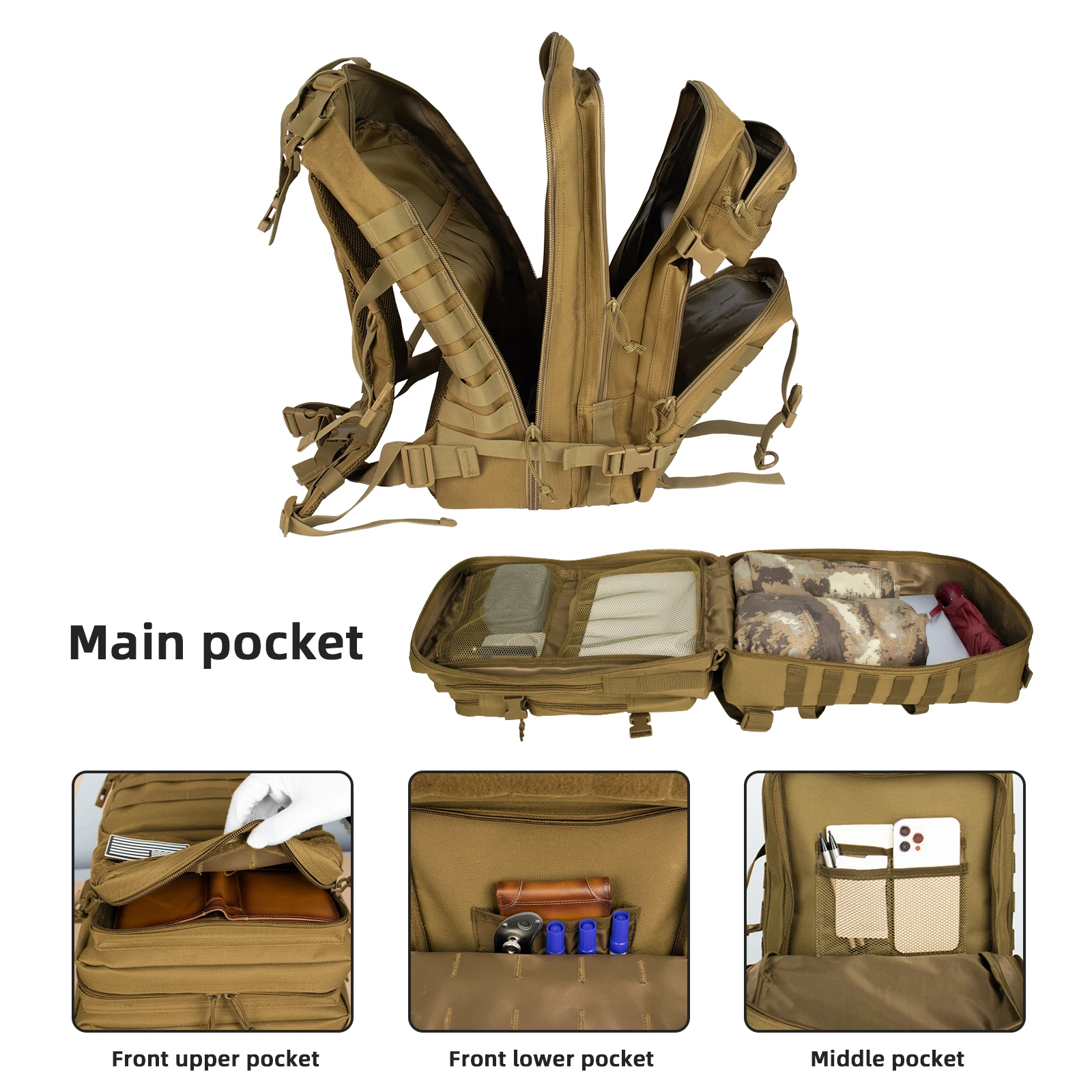
C. Handle Construction
Well-designed carrying handles complement the shoulder straps while providing alternative carrying options:
- Reinforced leather handles: Multiple layers laminated and stitched for strength
- Rolled edge construction: Eliminates sharp edges for comfortable grip
- Core-reinforced designs: Integrate rigid or semi-rigid materials for improved load distribution
- Ergonomic shaping: Contoured to match natural hand position
Handle circumference typically ranges from 4-5 inches (10-12.7 cm) for optimal ergonomics, with attachment methods carefully engineered to support the expected load without compromising the bag’s structure.
V. Supporting Materials
While leather and hardware form the visible foundation of roll-top designs, supporting materials play equally crucial roles in functionality and longevity. The right combination creates products that perform beautifully while developing character over time, like those in our vintage leather backpack collection.
A. Thread and Stitching
Thread selection significantly impacts both aesthetic appearance and structural integrity in roll-top designs:
- Polyester thread: Offers excellent UV resistance and maintains strength when wet
- Nylon thread: Provides superior abrasion resistance and elasticity
- Linen thread: Delivers traditional appearance with good tensile strength
- Waxed thread: Resists moisture and tangling during hand-stitching processes
Thread specifications matter tremendously:
– Thickness: Typically measured in Tex (weight in grams per 1000 meters) or Denier
– Bonding: Bonded threads resist fraying and maintain tension
– Tensile strength: Must exceed the tear strength of the leather
– Color selection: Matching, contrasting, or tonal options affect visual impact
Premium roll-top bags often feature specialized threads like Vinymo or Tiger Thread, known for exceptional longevity and clean stitching appearance. Stitch density and pattern design critically affect durability, particularly in the repeatedly folded roll-top area.
B. Adhesives and Reinforcements
Quality adhesives complement stitching to create strong bonds while internal reinforcements maintain structure:
- Contact cement: Creates permanent bonds between leather layers
- Edge coating adhesives: Seal and finish raw leather edges
- Water-based adhesives: Offer environmental benefits with adequate strength
- Solvent-based adhesives: Provide maximum bond strength for critical components
Internal reinforcement materials include:
– Bontex: A flexible fiberboard that maintains shape without excessive rigidity
– Stabilizers: Prevent stretching while allowing controlled flexibility
– Interfacing materials: Enhance structure without adding significant weight
– Stiffeners: Maintain proper opening shape in roll-top sections
These materials typically remain invisible in the finished product but dramatically impact performance and longevity.
C. Lining Materials
Interior lining materials protect contents while enhancing the user experience:
- Pigskin: Offers luxurious feel with natural durability
- Canvas: Provides traditional appearance with good abrasion resistance
- Synthetic fabrics: Deliver specialized properties like water resistance or visibility
- Microfiber: Creates soft protection for electronic devices
Key considerations for lining selection include:
– Tear resistance: Must withstand daily use without snagging or ripping
– Abrasion resistance: Protects against wear from contents
– Breathability: Reduces moisture accumulation
– Cleaning properties: Affects long-term maintenance and appearance
Understanding waterproofing options for leather bags helps users maintain both exterior leather and interior linings for maximum weather protection.
14 Inch Leather Laptop Backpack, Brown Leather Backpack, Men's Leather Backpack, Vintage Leather Backpack
Price range: $177.28 through $199.12 Select options This product has multiple variants. The options may be chosen on the product pageCarry On Leather Backpack, Roll Top Leather Backpack
Price range: $77.76 through $96.48 Select options This product has multiple variants. The options may be chosen on the product page- Price range: $80.72 through $108.04 Select options This product has multiple variants. The options may be chosen on the product page
Full Grain Leather Backpack, Men's Leather Laptop Backpack, Men's Leather Work Backpack
$353.46 Select options This product has multiple variants. The options may be chosen on the product pageMen's Leather Backpack, Men's Leather Laptop Backpack, Vintage Leather Backpack
Price range: $487.99 through $811.41 Select options This product has multiple variants. The options may be chosen on the product page17 Inch Leather Laptop Backpack, Full Grain Leather Backpack, Men's Leather Backpack, Men's Leather Travel Backpack, Vintage Leather Backpack
Price range: $234.91 through $284.86 Select options This product has multiple variants. The options may be chosen on the product page
VI. Protective and Finishing Materials
The final materials applied to roll-top leather designs dramatically affect both appearance and performance in various environments.
A. Weather Protection
Weather protection materials create crucial barriers against moisture and environmental damage:
- Leather conditioners: Replenish natural oils to maintain flexibility at fold points
- Beeswax-based products: Create effective water barriers with natural materials
- Synthetic waxes: Offer enhanced durability and easier application
- Silicone treatments: Provide invisible protection without changing leather appearance
- Edge sealants: Prevent moisture absorption through exposed edges
Applying these protective materials requires careful consideration:
– Different leather types require specific protectants
– Application frequency varies based on usage environment and leather type
– Over-application can affect breathability and appearance
– Some protectants darken leather or affect its natural patina development
For roll-top designs specifically, protecting the repeatedly folded area prevents premature cracking or damage from the mechanical stress of opening and closing.
B. Aesthetic Finishes
Finishing materials enhance appearance while providing additional protection:
- Burnishing compounds: Smooth and seal edges for professional appearance
- Dyes and pigments: Allow color customization or restoration
- Matte finishes: Create subtle, understated appearance
- Glossy sealants: Enhance color depth and provide additional protection
- Antique finishes: Create immediate character and depth
These finishes contribute significantly to the overall aesthetic:
– Traditional techniques like hand-burnishing create artisanal character
– Modern clear-coat finishes offer enhanced protection with minimal maintenance
– Patina accelerators create “broken-in” appearance immediately
– Edge treatments prevent fraying while enhancing visual appeal
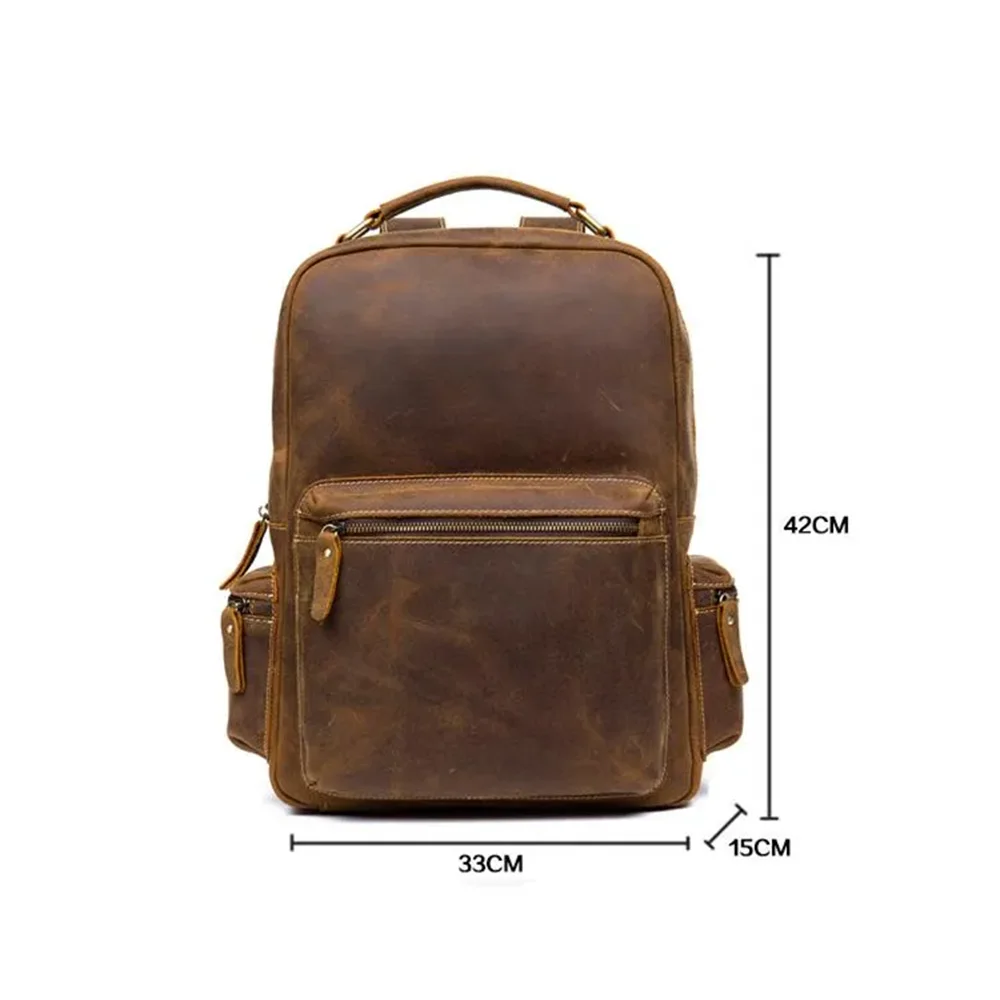
The combination of base materials and finishing treatments creates the distinctive character that makes each roll-top design unique.
VII. Quality and Sourcing Considerations
The materials used in roll-top leather designs reflect broader quality and ethical considerations that increasingly matter to discerning consumers.
Quality leather materials exhibit specific characteristics:
– Tight, uniform fiber structure visible at cut edges
– Even coloration with natural variation rather than artificial uniformity
– Consistent thickness throughout the hide
– Minimal surface flaws or processing marks
– Rich, natural leather aroma
Sustainable sourcing practices have gained importance:
– Responsible tanning processes that minimize environmental impact
– Ethical animal husbandry practices for leather sources
– Hardware manufactured with recycled metal content
– Reduction of synthetic components that cannot biodegrade
When examining roll-top leather products, look for:
– Clean, consistent stitching with appropriate thread tension
– Even application of dyes and finishes
– Smooth operation of all hardware components
– Reinforcement at high-stress points
– Thoughtful design that minimizes material waste
Understanding how roll-top leather backpacks work helps consumers recognize quality construction and materials that justify investment in premium products.
VIII. Common Issues and Solutions
Will full-grain leather be too stiff for a roll-top design?
Initially, full-grain leather may feel stiff, but with proper conditioning and break-in time, it becomes increasingly pliable while maintaining structure. Many premium roll-top designs intentionally use slightly thinner full-grain leather (5-6 oz) for the rolling portion while using thicker leather (7-8 oz) for the bag’s body.
Do chrome-tanned leathers provide enough structure for roll-tops?
Chrome-tanned leathers typically offer excellent flexibility but may lack structure. Manufacturers address this by incorporating internal stabilizers or using slightly thicker chrome-tanned leather. Some designs combine chrome-tanned leather for the roll-top portion with vegetable-tanned leather for structural elements.
Are brass hardware components worth the extra weight?
For designs emphasizing heritage aesthetics and maximum durability, solid brass hardware justifies its weight penalty. The material develops a beautiful patina alongside the leather and offers exceptional longevity. For travel-oriented or lightweight designs, aluminum or stainless steel alternatives provide strength with less weight.
Should thread color match or contrast with leather?
Thread color selection depends on the desired aesthetic effect. Matching thread creates a seamless, refined appearance, while contrasting thread highlights craftsmanship and creates visual interest. Many premium designs use subtle tonal variation—thread slightly darker or lighter than the leather—for sophisticated detailing.
IX. Material Selection Guide
When selecting materials for roll-top leather designs, consider how your intended use affects material requirements:
For Urban Daily Use:
– Medium-weight full-grain or top-grain leather (5-6 oz)
– Water-resistant treatments for unexpected weather
– Lighter hardware to reduce overall weight
– Comfortable padded straps for daily commuting
– Sleek, minimalist closure systems
For Outdoor/Adventure Use:
– Thicker, oil-tanned or pull-up leathers (6-7 oz)
– Heavy-duty waterproofing treatments
– Reinforced stress points and corners
– Durable hardware with secure closure systems
– Weather-resistant linings
For Professional Environments:
– Refined, smooth-grain leathers with elegant finish
– Sophisticated hardware with minimal noise
– Structured design that maintains professional appearance
– Interior organization for business essentials
– Ergonomic strap design for comfort with formal attire
Maintaining leather roll-top designs requires understanding specific care requirements based on materials used. Leather maintenance guides for commuters provide essential information for preserving both functionality and appearance during daily use.
The perfect roll-top leather design balances material selection with functional requirements, creating pieces that not only serve practical needs but develop character and beauty through years of use.

